Growing up in our ancestral home in Pilar, Bataan, Sunday lunches were always special when my Lolo Benjamin would prepare his legendary Pata Tim. The rich aroma of star anise and soy sauce would smell through our wooden windows, drawing curious neighbors to peek into our kitchen where this Chinese-Filipino masterpiece slowly simmered to perfection.
My Lolo, who learned this recipe from his own father in Binondo, always said that Pata Tim wasn't just about the tender, fall-off-the-bone meat or the velvety sauce that makes you want to drizzle it over endless cups of rice, it was about patience and love. "Hindi pwedeng magmadali sa Pata Tim," he'd remind me as I watched him carefully sear the pork leg until golden brown.
Decades later, whenever I make this heirloom recipe in my own kitchen, each bite brings me back to those precious Sundays, and I can almost hear the happy chaos of my cousins fighting over the last spoonful of that glossy, collagen-rich sauce.
This tried-and-tested Pata Tim recipe carries the same magic that made everyone at my Lolo's table fall silent with that first heavenly bite.
Jump to:
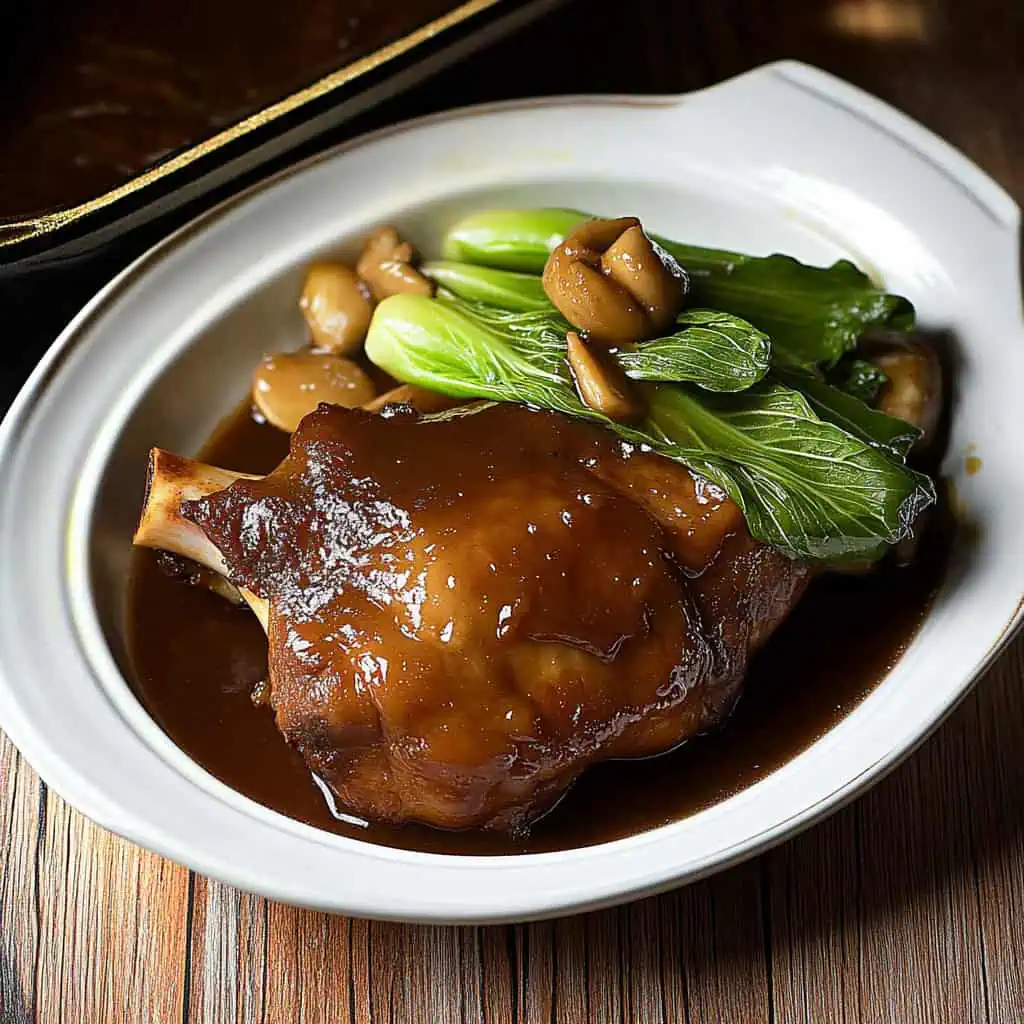
Why You'll Love This Recipe
- Fall-off-the-bone Tender: The meat becomes so tender it practically melts in your mouth (Malambot na malambot)
- Rich, Complex Sauce: A perfect blend of sweet, savory, and aromatic flavors (Masarap na sarsa)
- Make-Ahead Friendly: Tastes even better the next day
- Impressive Presentation: Perfect for special occasions
- Complete Meal: Includes vegetables for a balanced dish
Ingredients
The ingredients in this Pata Tim create a perfect harmony of flavors and textures. The pork leg offers rich meat and collagen that breaks down during long cooking, creating that sought-after melt-in-your-mouth tenderness. Shaoxing wine adds depth and helps remove any gaminess, while the combination of soy sauce, vinegar, and brown sugar creates the signature sweet-savory balance essential to Filipino-Chinese cuisine.
Star anise provides the distinctive aromatic quality that defines authentic Pata Tim, while fresh ginger and garlic add warmth and complexity. The vegetables – shiitake mushrooms and bok choy – complement the rich meat with earthy flavors and a fresh contrast.
Together, these ingredients transform a humble pork leg into an extraordinary dish where every element serves a purpose in building layers of flavor.
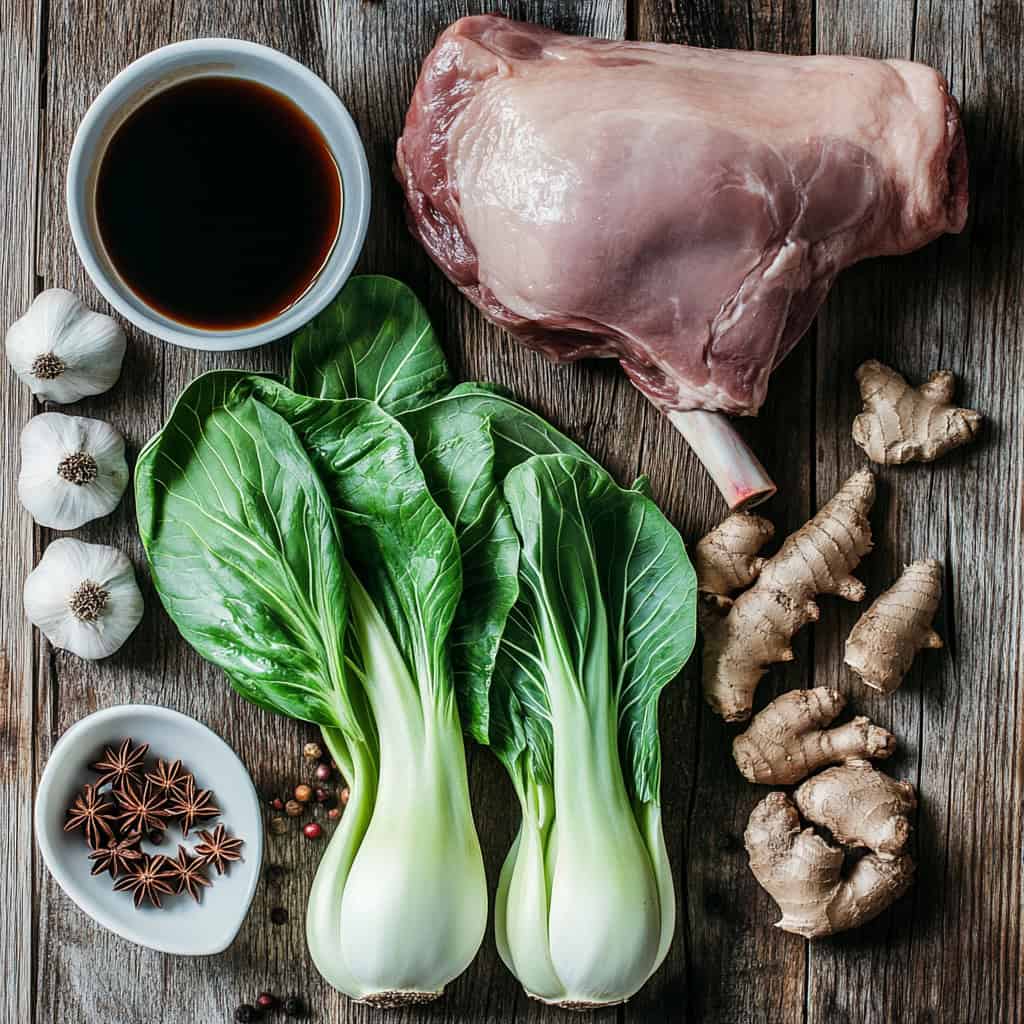
For the Main Dish
- 4 pounds whole pork leg (pata)
- ½ cup Shaoxing wine (Chinese cooking wine)
- 1 cup premium soy sauce
- ¼ cup white vinegar
- ½ cup brown sugar
- 3 whole star anise
- 4 cups water
- 3 tablespoons cooking oil
For the Vegetables
- 4 pieces fresh shiitake mushrooms
- 1 large bundle bok choy
- 2 pieces dried bay leaves
- 1 whole garlic head, halved crosswise
- 2-inch ginger, sliced
Equipment Needed
- Large heavy-bottomed pot or Dutch oven: Essential for proper braising and heat distribution. The heavy bottom prevents burning while the tight-fitting lid traps moisture.
- Tongs: For safely handling and turning the hot pork leg during searing and cooking.
- Sharp knife: To score the skin in a diamond pattern, which helps render fat and absorb flavor.
- Large serving platter: To present the finished dish beautifully.
- Strainer: For separating and refining the sauce if desired.
- Kitchen twine (optional): To tie the pork leg for maintaining its shape during the long cooking process.
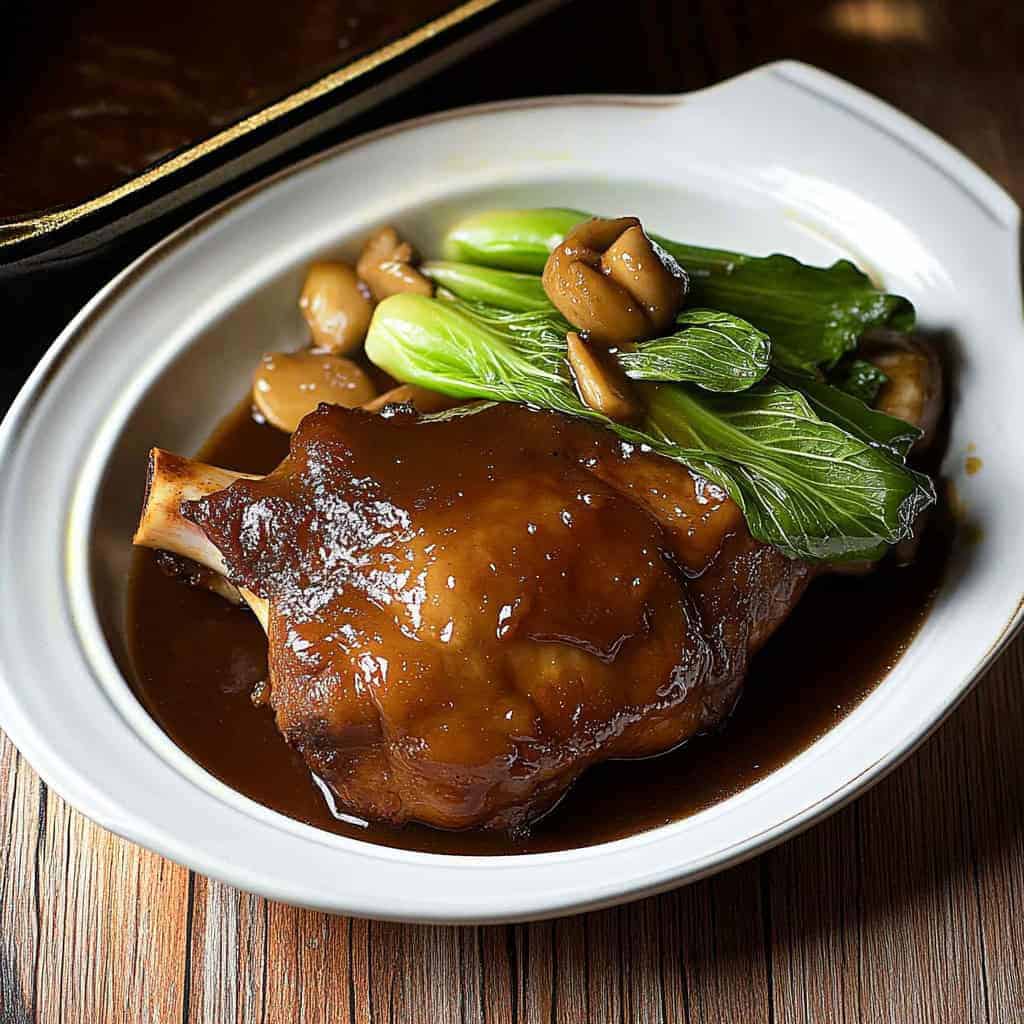
How To Make
- Begin by cleaning the pork leg thoroughly with cold water. Pat it completely dry using paper towels. Score the skin in a diamond pattern without cutting into the meat. Allow the meat to rest at room temperature for 30 minutes before cooking.
- Heat your pot over high heat. Add cooking oil and wait until it starts to shimmer. Carefully place the pork leg in the hot oil and sear each side until golden brown, about 3-4 minutes per side. Remove the pork and set aside on a clean plate.
- In the same pot over medium-high heat, combine the Shaoxing wine, soy sauce, white vinegar, and brown sugar. Add the star anise and water. Stir the mixture until the sugar completely dissolves. Bring this mixture to a gentle boil.
- Return the seared pork leg to the pot. Add the halved garlic head, sliced ginger, and bay leaves. Once the liquid returns to a boil, reduce the heat to low to maintain a gentle simmer. Cover the pot with a lid.
- Let the pork cook for 2 to 2.5 hours, turning it every 30 minutes to ensure even cooking. The liquid should be gently bubbling, never at a rolling boil. If the liquid reduces too much, add hot water half a cup at a time.
- When the meat is nearly tender, about 30 minutes before finishing, add the shiitake mushrooms to the pot. The mushrooms will absorb the flavorful broth while cooking.
- Check the meat's tenderness by inserting a fork – it should enter easily with minimal resistance. The meat should be very tender but still holding its shape.
- Blanch the bok choy separately in boiling water for 2-3 minutes until tender-crisp. Remove and set aside.
- Once the meat is fully tender, carefully transfer it to a serving platter. If the sauce seems too thin, strain it and return it to the pot. Simmer the sauce over medium heat until it reaches your desired consistency. The sauce should coat the back of a spoon.
- Arrange the blanched bok choy and cooked mushrooms around the pork leg. Pour the hot sauce over the meat and vegetables.
- Serve the Pata Tim immediately while hot with steaming white rice. Offer additional sauce in a separate bowl for those who want extra.
- For best results, let the entire dish rest for 10 minutes before serving to allow the flavors to settle. This also makes it easier to portion the meat, which should now be tender enough to cut with minimal effort.

Tips from Lola's Kitchen
Meat Selection
- Choose pork leg with skin on for better texture and flavor
- Look for pinkish-red meat with clean white fat
- Front leg (fore leg) is generally meatier than back leg
- Ask your butcher to clean and trim the leg properly
Flavor Enhancement
- For deeper flavor, marinate the pork overnight in the refrigerator
- Toast the star anise briefly in a dry pan before adding to intensify the aroma
- Add a splash of dark soy sauce (not regular soy sauce) for richer color
- Never skip the searing step - it creates the foundation for amazing flavor
- Use rock sugar instead of brown sugar for an authentic Chinese touch
Texture Perfection
- Don't rush the cooking process - low and slow is the key to tenderness
- Keep the liquid at a gentle simmer, never a rolling boil
- Turn the meat every 30 minutes for even cooking and flavor absorption
- The meat should be tender but still hold its shape when done properly
Substitutions
- Pork Leg: Can be replaced with pork belly (liempo) or pork shoulder for a different but equally delicious result
- Shaoxing Wine: Dry sherry or rice wine work well; for non-alcoholic version, use chicken broth with a splash of rice vinegar
- Shiitake Mushrooms: Button mushrooms or wooden ear mushrooms (tenga ng daga) provide different textures but work nicely
- Bok Choy: Napa cabbage, spinach, or regular cabbage can be substituted
- Star Anise: Five-spice powder can work in a pinch (use 1 teaspoon)
- Brown Sugar: Palm sugar or rock sugar adds authentic flavor
Troubleshooting
Tough Meat
- Problem: Meat remains tough even after long cooking
- Solution: Cook longer at an even lower temperature; sometimes it just needs more time
- Add hot water (not cold) if the liquid reduces too much during extended cooking
- Check that your pot has a tight-fitting lid to prevent moisture loss
Too Salty
- Problem: The sauce is overly salty
- Solution: Add peeled potato chunks while cooking (they'll absorb excess salt)
- Increase the water ratio slightly and reduce the sauce less
- Balance with a tablespoon of sugar to counteract saltiness
Sauce Too Thin
- Problem: The sauce isn't thick enough
- Solution: Remove the meat and vegetables, then reduce the sauce over medium heat
- The sauce naturally thickens when cooled due to the collagen from the pork skin
- For quicker results, make a slurry with 1 teaspoon cornstarch and 2 tablespoons cold water
Skin Not Tender
- Problem: The skin remains tough while the meat is tender
- Solution: Score the skin more deeply before cooking
- Ensure the skin is submerged in the braising liquid for most of the cooking time
- Increase cooking time by 30 minutes with the skin side down
Storage & Reheating
Storage
- Refrigerate in an airtight container for up to 4 days
- For best results, store the meat and sauce together to prevent drying
- Freeze for up to 3 months (preferably with the sauce in a separate container)
- Allow the dish to cool completely before refrigerating or freezing
Reheating
- Stovetop: Reheat on low heat with added water or broth to maintain moisture
- Add 2-3 tablespoons of water to prevent drying out
- Cover while reheating to retain moisture and prevent splattering
- Microwave: Use 70% power with a damp paper towel covering the dish
- Oven: 300°F in a covered dish with a few tablespoons of added liquid
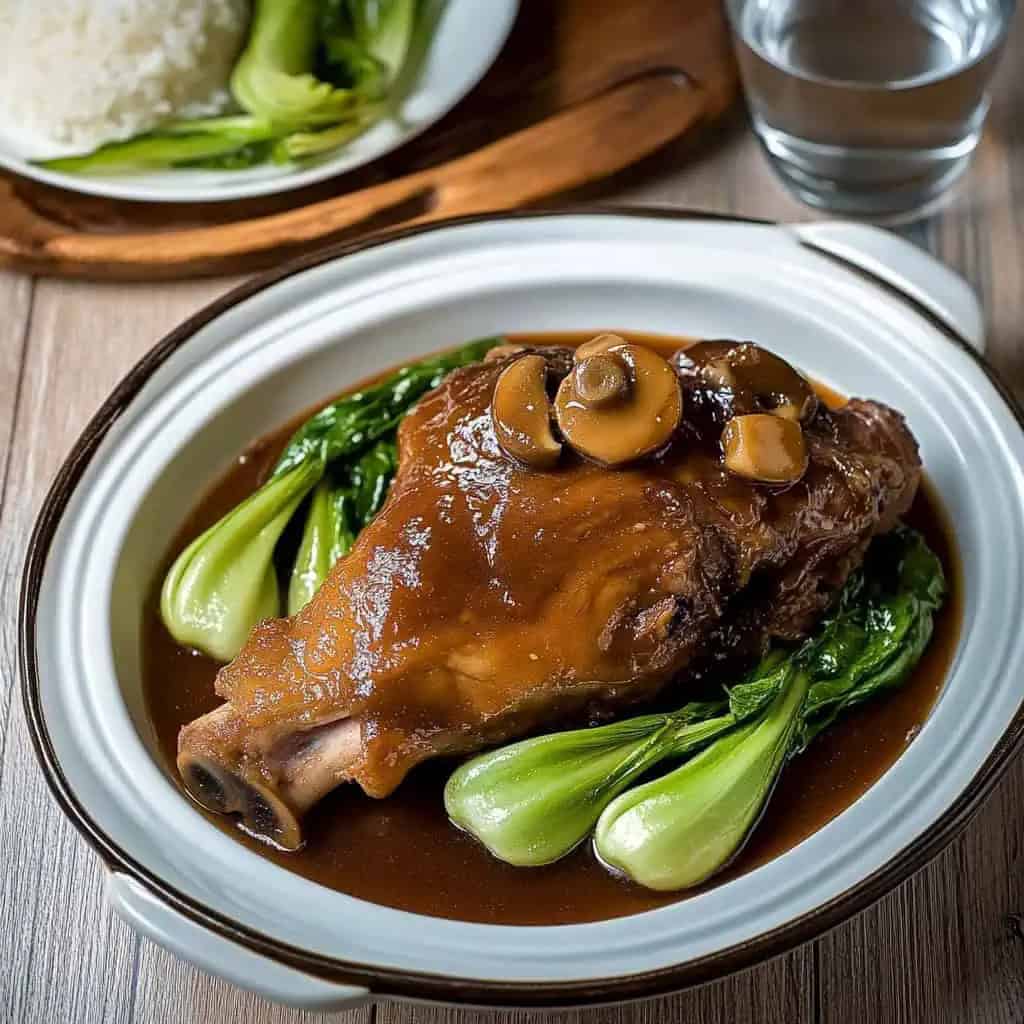
FAQ
Why isn't my meat falling off the bone?
The cooking temperature might be too high. Ensure it's at a gentle simmer and give it more time. Pata Tim needs patience - sometimes it needs an extra 30-60 minutes depending on the size and age of the pork.
Can I make this in a pressure cooker?
Yes, reduce cooking time to 45 minutes on high pressure with natural release. However, the traditional slow-braised method develops deeper flavors.
How do I know when it's done?
The meat should easily yield to a fork and feel tender when pressed. The collagen in the skin should be soft and gelatinous.
Can I make this ahead for a party?
Absolutely! The flavors improve overnight. Reheat gently on the stovetop with a splash of water or broth.
What's the best cut of pork leg to use?
The front leg (trotter end) has more meat, while the hock end has more skin and collagen. Both work well, but many prefer the meatier front leg for serving guests.
Is it necessary to blanch the pork leg first?
While not included in this recipe, blanching for 5 minutes in boiling water helps remove impurities and results in a cleaner-tasting sauce. It's optional but recommended for first-time makers.
Can I add vegetables other than those listed?
Yes! Carrots, daikon radish, and cabbage are excellent additions. Add firmer vegetables like carrots earlier in the cooking process.
What can I do with leftover sauce?
The sauce is liquid gold! Use it as a base for other braises, as a flavoring for noodle soups, or to season stir-fried vegetables.
Related
Looking for other recipes like this? Try these:
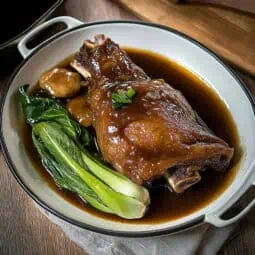
Filipino Pata Tim (Chinese-Style Braised Pork Leg)
Equipment
- Large heavy-bottomed pot or Dutch oven
- Tongs for handling meat
- Sharp knife
- Large serving platter
- Strainer
- Kitchen twine (optional)
Ingredients
- For the Main Dish
- 4 pounds whole pork leg pata [Paa ng baboy]
- ½ cup Shaoxing wine [Chinese cooking wine]
- 1 cup premium soy sauce [Toyo]
- ¼ cup white vinegar [Suka]
- ½ cup brown sugar [Asukal]
- 3 whole star anise [Sangke]
- 4 cups water [Tubig]
- 3 tablespoons cooking oil [Mantika]
- For the Vegetables
- 4 pieces fresh shiitake mushrooms [Kabute]
- 1 large bundle bok choy [Pechay Baguio]
- 2 pieces dried bay leaves [Dahon ng laurel]
- 1 whole garlic head halved crosswise [Bawang]
- 2- inch ginger sliced [Luya]
Instructions
- Begin by cleaning the pork leg (pata) thoroughly with cold water. Pat it completely dry using paper towels [Punasan ng tuyo ang karne]. Score the skin in a diamond pattern without cutting into the meat [Markahan ang balat ng karne ng pahalang at patayo]. Allow the meat to rest at room temperature for 30 minutes before cooking.
- Heat your pot over high heat (200°C/400°F). Add cooking oil (mantika) and wait until it starts to shimmer. Carefully place the pork leg in the hot oil and sear each side until golden brown, about 3-4 minutes per side [Iprito ang bawat gilid hanggang maging golden brown]. Remove the pork and set aside on a clean plate.
- In the same pot over medium-high heat (180°C/350°F), combine the Shaoxing wine, soy sauce (toyo), white vinegar (suka), and brown sugar (asukal na pula). Add the star anise (sangke) and water (tubig). Stir the mixture until the sugar completely dissolves [Haluin hanggang matunaw ang asukal]. Bring this mixture to a gentle boil.
- Return the seared pork leg to the pot. Add the halved garlic head (bawang), sliced ginger (luya), and bay leaves (dahon ng laurel). Once the liquid returns to a boil, reduce the heat to low (150°C/300°F) to maintain a gentle simmer [Pahinain ang apoy]. Cover the pot with a lid.
- Let the pork cook for 2 to 2.5 hours, turning it every 30 minutes to ensure even cooking [Baliktarin ang karne tuwing 30 minuto]. The liquid should be gently bubbling, never at a rolling boil. If the liquid reduces too much, add hot water half a cup at a time.
- When the meat is nearly tender, about 30 minutes before finishing, add the shiitake mushrooms (kabute) to the pot. The mushrooms will absorb the flavorful broth while cooking.
- Check the meat's tenderness by inserting a fork – it should enter easily with minimal resistance [Subukan ang lambot ng karne gamit ang tinidor]. The meat should be very tender but still holding its shape.
- Blanch the bok choy (pechay baguio) separately in boiling water for 2-3 minutes until tender-crisp [Pakuluan ng saglit ang pechay]. Remove and set aside.
- Once the meat is fully tender, carefully transfer it to a serving platter. If the sauce seems too thin, strain it and return it to the pot. Simmer the sauce over medium heat until it reaches your desired consistency [Palaputan ang sarsa kung kinakailangan]. The sauce should coat the back of a spoon.
- Arrange the blanched bok choy and cooked mushrooms around the pork leg. Pour the hot sauce over the meat and vegetables.
- Serve the Pata Tim immediately while hot with steaming white rice (mainit na kanin). Offer additional sauce in a separate bowl for those who want extra [Maghain ng dagdag na sarsa].
- For best results, let the entire dish rest for 10 minutes before serving to allow the flavors to settle [Pahintulutin muna ang lutong magsettle bago ihain]. This also makes it easier to portion the meat, which should now be tender enough to cut with minimal effort.
- If you plan to serve it the next day, let the dish cool completely before refrigerating. When reheating, do so gently over low heat (150°C/300°F), adding a small amount of water if needed to maintain the sauce's consistency [Painitin ng dahan-dahan at magdagdag ng kaunting tubig kung kinakailangan].
Tips from Lola's Kitchen
- Meat Selection
- Choose pata with skin on for better texture
- Look for pinkish-red meat with white fat
- Front leg (fore leg) is meatier than back leg
- Flavor Enhancement
- Marinate pork overnight for deeper flavor
- Toast star anise briefly before adding
- Add a splash of dark soy sauce for color
- Never skip the searing step
- Texture Tips
- Don't rush the cooking process
- Keep liquid at a gentle simmer
- Turn meat every 30 minutes for even cooking
Nutrition
The Story Behind Pata Tim (Chinese-Style Braised Pork Leg)
Picture yourself walking through the bustling streets of Binondo, Manila's historic Chinatown, where the aromatic fusion of Filipino and Chinese cuisines has been perfecting itself for over four centuries. Among these culinary treasures, Pata Tim (巴蹄) stands as a testament to the beautiful marriage of these two rich food cultures, combining Chinese braising techniques with Filipino flavors to create something truly extraordinary.
The name itself tells a story – "Pata" being the Filipino word for pork leg, while "Tim" comes from the Hokkien word "tim" (滷), meaning to braise or stew. This linguistic fusion perfectly represents how Chinese immigrants adapted their cooking methods to local ingredients, creating dishes that would become beloved staples in Filipino households.
Originally, this dish was served in the lauriat (traditional Chinese ceremonial banquets) of wealthy Chinese-Filipino families during special occasions. The slow-cooking method was particularly significant because it represented patience and dedication – qualities highly valued in both cultures. The tender meat falling off the bone symbolized abundance and prosperity, making it a favorite during New Year celebrations and important family gatherings.
What sets Pata Tim apart from other braised pork dishes is its unique combination of aromatics. The star anise, a signature Chinese spicing element, works in harmony with local Filipino ingredients to create that distinctively rich, sweet-savory sauce that Filipinos lovingly call "sabaw na sarsa." The addition of Shaoxing wine – a traditional Chinese cooking wine – adds depth and complexity that simple braising could never achieve.
In modern Filipino cuisine, Pata Tim has evolved from being solely a special-occasion dish to becoming a beloved comfort food found in Chinese restaurants and Filipino homes alike. Its popularity has spawned numerous variations, from the addition of pineapple for sweetness to the incorporation of local vegetables like kangkong or pechay.
Today's home cooks have adapted the traditional preparation methods while maintaining the dish's essential character. While our ancestors might have cooked this over wood fires for half a day, modern kitchen equipment has made it possible to achieve that same tender, flavorful result in just a few hours – though many Filipino grandmothers will insist that the longer, traditional cooking method produces superior results.
The beauty of Pata Tim lies not just in its melt-in-your-mouth texture or its complex flavor profile, but in how it represents the very essence of Filipino cuisine – the ability to take foreign influences and transform them into something uniquely our own. It's a dish that tells the story of cultural integration, family celebrations, and the evolution of Filipino food culture.
Whether you're preparing this dish for a special celebration or simply wanting to elevate your regular family dinner, remember that you're not just cooking a meal – you're participating in a culinary tradition that has brought families together for generations. As the aroma fills your kitchen and the meat slowly tenderizes in its flavorful bath, you're recreating a piece of Filipino-Chinese heritage that continues to captivate food lovers around the world.
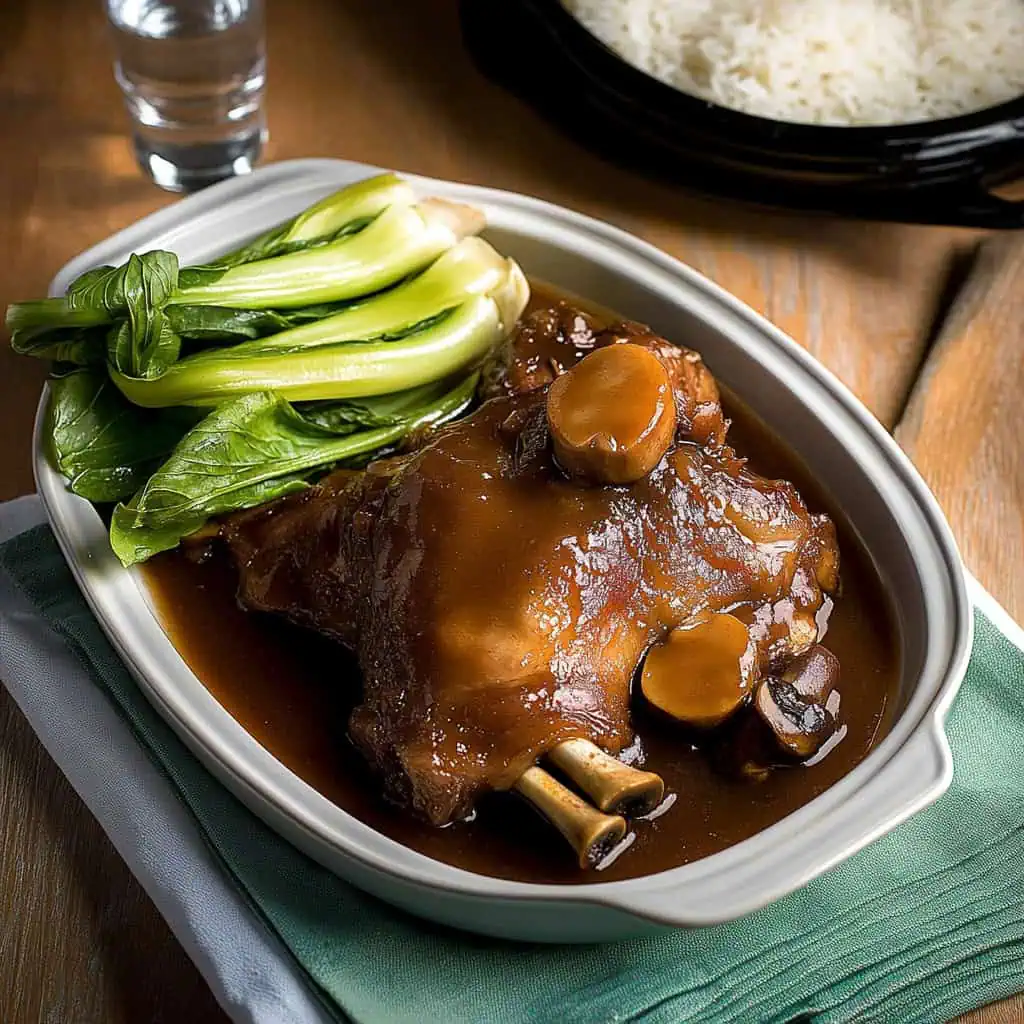









Comments
No Comments